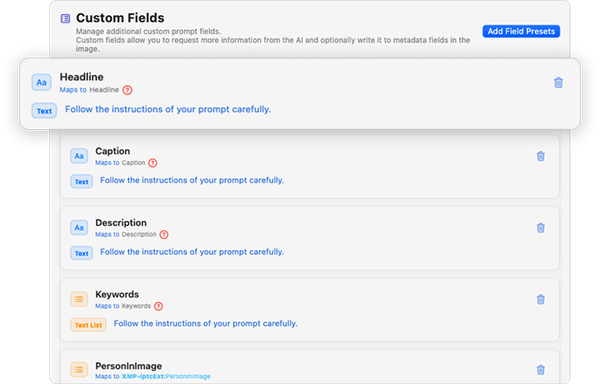Understanding Metadata Standards: What’s the Difference Between Exif, IPTC, and XMP?

If you’ve ever wondered what’s really going on behind the scenes of your photos — in those mysterious fields labeled Exif, IPTC, or XMP — you’re not alone. As photographers, editors, and digital asset managers, we interact with metadata constantly… but often without knowing which standard is doing what (or why it even matters).
So today, we’re kicking off: “Understanding Metadata Standards”, a multi-part deep dive designed to demystify these three major formats and show how MetadataAI™ works with all of them — seamlessly, safely, and powerfully.
Let’s begin with a fundamental question:
What Is Photo Metadata?
At its core, metadata is “data about data” — in this case, information about your image file. It might include:
- When and where the photo was taken
- What camera or lens was used
- Who is in the photo
- What’s happening in the scene
- Copyright, usage rights, and credits
Metadata is crucial for searchability, organization, licensing, and editorial use. But how this information is stored — and by which standard — varies. That’s where Exif, IPTC, and XMP come in.
The Three Standards: Exif, IPTC, and XMP
1. Exif (Exchangeable Image File Format)
Used for: Technical + capture data
Created by: JEITA (Japan Electronics and Information Technology Industries Association)
Lives in: Embedded inside JPEG, TIFF, and some RAW files
Common Exif Fields:
- Camera make and model
- Exposure settings
- Date/time taken
- GPS coordinates
- Orientation
Purpose:
Your camera or smartphone automatically writes Exif. It’s mostly technical — great for organizing, searching, and analyzing images based on how/when they were captured.
2. IPTC (International Press Telecommunications Council)
Used for: Descriptive + editorial metadata
Created by: The IPTC, a global standards body for news media
Lives in: Embedded in image files, often within legacy sections
Common IPTC Fields:
- Title / Headline
- Caption / Description
- Keywords
- Creator / Credit
- Copyright notice
- Location info
Purpose:
IPTC is the most widely adopted standard in newsrooms, wire services, and stock photography. It provides structure for descriptive data and ensures metadata travels with the file across systems.
3. XMP (Extensible Metadata Platform)
Used for: Custom + extended metadata
Created by: Adobe Systems
Lives in: Sidecar .xmp files or embedded in files (JPEG, TIFF, etc.)
Common XMP Uses:
- Duplicating IPTC or Exif fields in a modern XML format
- Including custom fields for DAMs, legal tags, ratings, AI labels
- Storing layered metadata for editing software like Lightroom
Purpose:
XMP is a flexible container for metadata — built to be extensible, scriptable, and machine-readable. It supports custom namespaces, letting companies or systems define their own metadata logic.
Summary Comparison Table
Feature | Exif | IPTC | XMP |
|---|---|---|---|
Main Use | Camera data | Editorial metadata | Custom, extensible data |
Editable by User? | Sometimes | Yes | Yes |
Standardized? | Yes (but rigid) | Yes | Yes (but flexible) |
Embedded in File? | Yes | Yes | Yes or Sidecar |
Common In… | All cameras | News, stock, editorial | Pro tools, DAMs |
Why MetadataAI™ Works Across All Three
Many tools on the market only edit one or two of these standards — or worse, overwrite one while ignoring the rest.
MetadataAI™ is built to handle all three intelligently and safely, so you don’t have to worry about file compatibility or missing tags. Here’s how:
- Reads and writes Exif, IPTC, and XMP — accurately
- Respects IPTC core and extended schemas
- Supports custom XMP namespaces for organization-specific fields
- Leverages ExifTool composite tags (more on that in Series B)
So whether you’re captioning a stock submission, tagging portraits for an archive, or preparing images for a breaking news cycle, you can be confident your metadata is going where it should — and staying consistent.
Common Pitfalls When Editing Metadata
Even experienced pros get tripped up by these issues:
- Writing metadata to only one format (e.g., IPTC) and ignoring XMP, which many systems now prefer
- Losing metadata when exporting from editing software that strips it
- Creating duplicate/conflicting fields across Exif/IPTC/XMP
- Failing to update legacy fields like IPTC:Caption in sync with modern XMP:Description
MetadataAI™ avoids these pitfalls by using composite tag strategies and smart syncing logic — which we’ll explore further in a future post.
Coming up next... we’ll explore:
How MetadataAI™ Reads and Writes All Metadata Types — Seamlessly
You’ll learn:
- Why many tools overwrite or break metadata
- How MetadataAI respects and aligns standards
- How our dual-mode approach (UI + CLI) helps both humans and machines get it right
✅ Try MetadataAI™ Free
Want to test how your own files are tagged across Exif, IPTC, and XMP? Head over to metadataai.app to download the desktop app and get 50 free credits to try it out.
Process your images with AI-powered prompts and inspect exactly how your metadata is being enriched — across all three standards.




